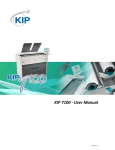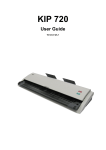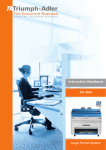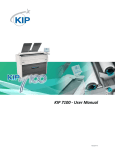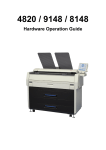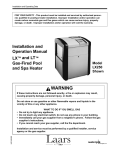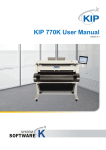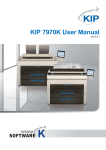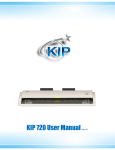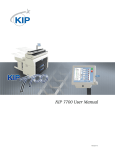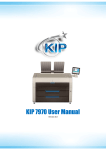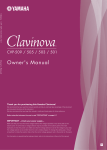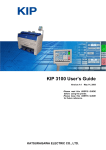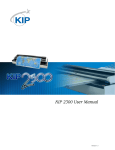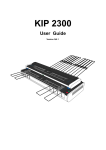Download KIP 700m - User Manual - KIP
Transcript
KIP 700m - User Manual Version A1 Thank you for purchasing the Multi-Function Printer KIP 700m. This Hardware Operation Guide contains functional and operational explanations for the KIP 700m. Please read this Hardware Operation Guide carefully before using the printer. Please keep this Hardware Operation Guide for future reference. 1. When this product is installed in North America. This device complies with part 15 of the FCC Rules. Operation is subject to the following two conditions: (1) This device may not cause harmful interference, and (2) this device must accept any interference received, including interference that may cause undesired operation. 2. When this product is installed in Europe This equipment complies with the requirements in Pub.22 of CISPR Rules for a Class B computing device. Operation of this equipment in a residential area may cause unacceptable interference to radio and TV reception requiring the operator to take whatever steps are necessary to correct the interference. Do not install Machine around other electronic equipment or other precision instruments. Other devices may be effected by electrical noise during operation. If the Machine is installed near other electronic equipment, such as a TV or a radio, interference to said equipment, such as noise or flickering, may occur. Use a separate power line and install the PRINTER as far as possible from said equipment. As an ENERGY STAR ® Partner, Katsuragawa Electric Co., Ltd. has determined that this product meets the ENERGY STAR ® guidelines for energy efficiency. The International ENERGY STAR ® Office Equipment Program is an international program that promotes energy saving through the penetration of energy efficient computers and other office equipment. The program backs the development and dissemination of products with functions that effectively reduce energy consumption. It is an open system in which business proprietors can participate voluntarily. The targeted products are office equipment such as computers, monitors, printers, facsimiles, copiers, scanners, and multifunction devices. Their standards and logos are uniform among participating nations. The symbol shown indicates that this product conforms to Directive 2002/96/EC of the European Parliament and the council of 27 January 2003 on waste electrical and electronic equipment (WEEE) and does not apply to countries outside of EU. The symbol shown indicates that this product conforms to SJ/T11364-2006 of People’s Republic of China Electronic Industry Standard and does not apply to countries outside of People’s Republic of China. The symbol shown indicates that this product conforms to GB 18455-2001 11364-2006 of National Standard of the People’s Republic of China and does not apply to countries outside of People’s Republic of China. (1) Safety Warnings The following warnings are very important in order to safely use this product. These notes are important in preventing danger to the operator or operation of the printer. The following symbols are found throughout the USER’S Manual and have the following meaning: WARNING This WARNING mark means that there is a possibility of death or serious injury if you ignore or do not follow the said instruction. CAUTION This CAUTION mark means that there is a possibility of injury or physical damage if you ignore or do not follow the said instruction. When marked with this symbol, “DO NOT ATTEMPT” When marked with this symbol, “pay close attention to” (2) WARNING Ground the product with a correct ground source or you may be electrically shocked. 1. The Power source should be as follows: In U.S.A. : 120V plus/minus10%, 50/60Hz, 15A or higher In Europe : 220-240V plus6% or minus10%, 50/60Hz, 10A or higher 2. Use a circuit with a dedicated breaker. 3. Install the product as close to the wall outlet as possible. 4. If you wish to move the printer, please contact your service personnel. 1. Do not remove the screw and do not open the cover if not instructed to do so in this User’s Manual. If you ignore this warning, you may be burnt or receive an electric shock due to a hot item or electrically charged part inside of the printer. 2. Do not disassemble or tamper with the printer. It may result in a fire or an electrical shock. 1. Do not plug in the printer into a multi-wire connector in which some other equipment is plugged into. It may cause a fire due to outlet overheating. 2. Do not damage the Power Cord by stepping on or placing heavy items on it. If the Power Cord is damaged, it may cause a fire or you may receive an electric shock. REPLACE THE CORD IF DAMAGED! 1. Do not put a flower vase, a flowerpot or any water-filled item on the product. Spilt water could cause a fire or an electric shock. 2. If the product generates an abnormal smell or noise, turn it off and unplug it from the wall electrical outlet immediately. Do not throw the toner into a fire or other sources of heat, as it can explode. (3) CAUTION Do not install the printer in a humidified room or a dusty room. Also, do not install the printer on an unstable floor as injuries may occur. 1. Unplug the printer before you move it. The power cord may be damaged and it may result in a fire or electric shock. 2. If you do not use the printer for a long duration (holidays, company shutdown) turn off and unplug the printer from the outlet for safety. Do not pull the cord when you unplug the printer as you may damage the Power Cord. There are hot items inside of the printer. Take great care not to touch these items when you remove mis-fed media. Ventilate the room well if you print in a small area. (4) POWER CORD INSTRUCTION The installation of (or exchange to) a power plug which fits in the wall outlet of the installation location shall be conducted in accordance with the following: WARNING Select a power plug which meets the following criteria; - The plug has a voltage and current rating appropriate for the product’s rating marked on its name plate. - The plug meets regulatory requirements for the area. - The plug is provided with a grounding pin or terminal. If the appropriate plug does not fit the wall outlet in the installation, the customer shall install an appropriate outlet. Connector Type: Configuration Standard IEC60320:C13 Rating 10A 250V (IEC) 15A 125V (UL) Usually found in Rating 10A 250V Usually found in European countries KS C 8305 10A 250V Korea AS/NZS 3112 10A 250V Australia New Zealand GB1002 GB2099.1 10A 250V China IRAM 2073 10A 250V Argentina BS 1363 10A 250V United Kingdom SASO 2203 10A 250V Saudi Arabia BS 546A IS-1293 SABS-1293 15A 250V United Kingdom India South Africa SEV 1011 10A 250V Switzerland Plug Type: Model Rating 220-240V Configuration Standard CEE7/7 (5) Chapter 1 Before Use 1. 1 Installation Requirements page 1- 2 1. 2 Originals Prohibited from Duplication 1- 3 1. 3 Features 1- 4 1. 4 Specifications 1. 4. 1 General 1. 4. 2 Printer part 1. 4. 3 Scanner part 1111- 1. 5 Appearance 1. 5. 1 Front view 1. 5. 2 Rear view 1- 9 1- 9 1-10 1. 6 1-11 Specifications for the Scan Original 1. 7 Specifications for the Printing Paper 1. 7. 1 Papers not available to use 1. 7. 2 Keeping the paper in the custody 1. 7. 3 Treatment against environmental condition 1-1 5 5 7 8 1-14 1-14 1-15 1-16 Chapter 1 Before Use 1. 1 Installation Requirements The following conditions are required for installation of the equipment. 1. POWER SOURCE should be rated as follows. In U.S.A. : 120V plus/minus 10%, 50/60Hz, 15A or higher In Europe : 220-240V plus 6% or minus10%, 50/60Hz, 10A or higher 2. The equipment must be on an exclusive circuit. 3. The outlet must be near the equipment and easily accessible. 1. Make sure to connect this equipment to a grounded outlet. 2. For PLUGGABLE EQUIPMENT, the socket-outlet shall be installed near the equipment and shall be easily accessible. The site temperature range = 10 to 32 degrees Centigrade, with the humidity between 15% to 85% RH. (NON CONDENSING) Keep the printer away from water sources, boilers, humidifiers or refrigerators. 1. The installation site must not have open flames, dust or ammonia gases. 2. The equipment must not be exposed to the air vents from air conditioners. It may affect the image quality. 3. The equipment should not be exposed to the direct sunlight. Please draw curtains to block any sunlight. When you open the Movable Unit, do not expose the Photoconductive Drum to strong (intense) light as this will damage the Drum. Ozone will be generated while this equipment is use, although the quantity generated is within safe levels. (see certifications) Ventilate the room, if required. Keep ample room around the equipment to ensure comfortable operation. (Refer to the following figure.) The equipment must be leveled and the floor strength must be ample to sustain the weight of the equipment. 20cm/8” or larger with no option (Rear) KIP 700m 10cm/4” or larger 10cm/4” or larger (Front) 20cm/8” or larger 1-2 Chapter 1 Before Use 1. 2 Originals Prohibited from Duplication It is not necessarily allowed to copy every kind of original. You may be punished by the law if only you possess the copy of some kind of original. We recommend you to consider enough before you copy such original. [Originals prohibited from copying by the law] 1. It is not allowed to copy Currency (Bill, Money, Bank Note, etc.), Government issued Negotiable Instruments (National Bonds, Security, Local Debt Bonds, etc.). 2. It is not allowed to copy Foreign Currency or Foreign Negotiable Instruments. 3. It is not allowed to copy unused postal stamps or government postcards without permission to make replica from Government. 4. It is not allowed to copy Government issued revenue stamps, certificate stamps which are prescribed by Liquor Tax Act or the Commodity Tax Act. [Special items to be cared] 1. It is warned by the government to copy private issued securities (stock certificate, draft, check, goods ticket, etc.), commutation ticket or book of tickets, excluding that some specific company copies such originals as many as it requires for its own business. 2. We recommend you not to copy freely such originals as government issued passport, public or private issued licenses, automobile inspection certification, IDs and tickets like pass or meal. Reference Law Regulations to control fake currency and Bond. Control Law against Forged & faked Foreign Currency, Bill, Bank Note and Bond Forged postal stamps control law Forged revenue stamps control law Currency similarity securities Control Law Prohibited items to copy Currency (Bill, Money, Bank Note, etc.), Government issued Negotiable Instruments (National Bonds, Security, Local Debt Bonds, etc.) Foreign Currency or Foreign Negotiable Instruments Unused postal stamps or government postcards Government issued revenue stamps, and certificate stamps prescribed by Liquor Tax Act or Commodity Tax Act Private issued securities (stock, draft, check, goods ticket, etc.), commutation or book tickets [Originals protected by the copyright] It is prohibited to copy such originals as book, music, paintings, printed copy, maps, drawings, movie and pictures which are protected by the copyright, except for personnel or family use or similar purpose. 1-3 Chapter 1 Before Use 1. 3 Features (1) KIP 700m is a Multi-Function Printer for scan, copy and print large format documents. Some of these features may be optional. (2) Front loading - front delivery structure saves the installation space. (3) Various media source; roll media feeding (1 roll), cut sheet manual feeding, Paper Tray multiple cut sheet feeder (option). (4) A dedicated printer stand (option) offers easy print handling with the print basket. The KIP 700m is also suitable for your office layout as a desktop MFP. (5) The operation speed is 40mm/s (3 D landscape per minute). (6) The maximum print width is 914mm / 36” wide, and the minimum one is 210mm or 8.5”. The maximum print length is 2,400mm (for A0 / 36” wide media), and the minimum one is 297mm or 11”. (7) Up to 600dpi print resolutions with an enhanced scanning system produces the highest quality images controlled by an advanced KIP Image Process System. (8) The combination of KIP Contact Development System and mono-component minute toner can produce a high definition line, distinctive grayscale and consistent solid black. The KIP HDP process generates no Waste Toner. (9) Easy access to USB port allows users to provide efficient productivity by using “File to Print” / “Scan to USB” (option). (10) 2 inch core plain paper media support 1-4 Chapter 1 Before Use 1. 4 Specifications 1. 4. 1 General Subject Model Configuration Power consumption (Maximum) Power consumption (Low power mode) Acoustic noise Ozone Dimensions Weight Environmental condition for usage Interface Rating input power Specification KIP 700m Desktop Console (with the stand) 1500W (Including Scanner & Controller Unit) 30W or less Idling Max. 51db Printing Max. 60db (impulse sound excluded) EN ISO 7779 Max. 0.05ppm (Measurement method under UL Standard) 1245mm (Width) x 680mm (Depth) x 611mm (Height) (Stand excluded) About 144kg / 318lbs (Stand excluded) Temperature: 10 to 32 degrees Centigrade / 50 to 89.6 F Humidity: 15 to 85% RH Network Interface (10 BASE-T / 100 BASE-TX / 100BASE-T) In the US : 120V plus/minus 10%, 50/60Hz, 15A In Europe : 220-240V plus 6% or minus 10%, 50/60Hz, 10A NOTE The above specifications are subject to change without notice. 1-5 Chapter 1 Before Use 1. 4. 2 Printer part Subject Printing method Photoreceptor Print speed Print head Resolution of print head Print width Print length Specification LED Array Electro photography Organic Photoconductive Drum 40mm per second (Inch) 1.7ppm/E 3 ppm/D Landscape LED Array 600dpi x 600dpi Maximum 914mm / “36” Minimum 297mm / “11” for roll media 210mm / “8.5” for cut sheet Maximum (Standard) 2,400mm for A0 / 36” wide (plain paper / bond) or “2 x Standard length” (plain paper / bond) “1 x Standard length” (plain paper / bond, 2” core roll) “1 x Standard length” (vellum / tracing paper, film) (Option) 3,600m Minimum 297mm / 11” NOTE If the print is longer than 2,400mm, its image quality or the reliability of paper feeding is not guaranteed. Print size (from Paper Tray, option) ISO (mm) Width Length 594 420 297 420 X 297 210 X X X ANSI (inch) Width Length 24 22 18 17 12 11 Warm up time First print time Fusing method Development method 18 X 17 12 11 9 8.5 X X X X X X X Shorter than 2 minutes 30 seconds (At 23oC, 60%RH, the rated voltage, and plain paper is used) 43 seconds (D Landscape) (At 23oC, 60%RH, the rated voltage, and plain paper is used) Heat and Pressure Rollers Dry type non-magnetic mono-component toner NOTE The above specifications are subject to change without notice. 1-6 Chapter 1 Before Use Subject Media source Media Storage of consumables Specification 1 Roll Deck (3” / 2” core roll) Manual Feeder (single cut sheet) Paper Tray (multiple cut sheet, option) (Recommended Roll Media) - US model: Bond : 64g/m2 to 80g/m2, US Bond (PB-20) Vellum : US Vellum (XV-20) Film : 4MIL (PF-4DDME) - Europe/Asia model: Plain Paper : 64g/m2 to 80g/m2, Oce Red Label (75g/m2) Tracing Paper : Transparent Paper (80g/m2) Film : 3.5MIL - 2” roll core : Universal Bond (Cut sheet) Plain Paper / Bond (Toner cartridge) Store the cartridge within the temperature range from 0 to 40 degrees Centigrade and within the humidity range from 10 to 85% RH. NOTE The above specifications are subject to change without notice. 1-7 Chapter 1 Before Use 1. 4. 3 Scanner part Subject Scanning method Light source Setting of original Starting point of scan Scan width Scan length Margin area Optical resolution Digital resolution Original transportation Transportable original thickness Specification Contact Image Sensor (CIS) (5 pieces of A4 sized CIS) LED (R/G/B) Face up Center Max: 914.4mm / 36” Min : 279.4mm Max: 6,000mm / 19.7ft (Including the margin area) Min : 210mm / 8.5” (Including the margin area) 3mm from leading, trailing and both side edges 600dpi 200 / 300 / 400 / 600 dpi Sheet through type Max: 1.60mm Min : 0.05mm NOTE If the original is thicker than 0.65mm, its image quality is not guaranteed. Scanning speed 60mm per second (max) NOTE The above specifications are subject to change without notice. 1-8 Chapter 1 Before Use 1. 5 Appearance 1. 5. 1 Front view 3 7 5 7 9 12 1 10 13 4 11 7 7 2 12 8 2 No. 1 2 Name Main Switch Original Guides 3 User Interface 4 Emergent Stop Button 5 6 Scanner Unit Original Table 7 8 9 Engine Unit Open Lever Bypass Feeder Roll Deck Cover 10 11 Print Basket Stylus 12 13 Print Exit Cover USB port Function You can turn on/off the KIP 700m. Feed the original under the Scanner Unit along the Original Guides. This is a Touch Screen, and many kinds of user operation are available. PLEASE DO NOT push the LCD area too strong. Press this red button when you would like to stop copying or scanning emergently. Read the original with this unit when you make scan or copy. Place the original here and then feed it into the Scanner Unit when you make scan or copy. Push down these blue levers when you open the Engine Unit. Feed a cut sheet paper from the Bypass Feeder. Lift up to open the Roll Deck. A roll media can be loaded in the Roll Deck. Consult your sales dealer for optional media feed system. Receives ejected printed. Use this to press buttons on the touch screen. PLEASE DO NOT use any other pointed object to tap on the UI. Can access a mis-feed print inside the Fuser Unit. Your USB flash memory storage can be installed here. 5VDC max. 1-9 Chapter 1 Before Use 1. 5. 2 Rear view 2 1 7 7: behind 5 4 6 3 No. 1 2 Name Toner Cover Original Guide 3 LAN Port 4 5 6 7 USB Port Breaker Inlet Socket Dehumidify Heater Switch (Option) Function Open here to access toner supply system. These trays catch the original ejected from the Scanner Unit. Connect the LAN Cable to connect the KIP 700m to the network. (Do not connect a telephone line) Service Use, 5VDC max. It is possible to shut off supplying the AC power. Connect the Power Cord here. Turn on the Dehumidify Heater with this switch when you would like to dry the paper in the humid season. 1-10 Chapter 1 Before Use 1. 6 Specifications for the Scan Original A scan original must satisfy the following specifications. Thickness 0.05mm to 1.6mm Width 279.4mm to 914.4mm Length 210mm to 6,000mm (If an original is thicker than 0.65mm, its image quality is not guaranteed even it is transported.) Do not scan the following kinds of originals. The original or the scanner may damage. Sticked with paste Paste Torn Folded (Leading edge) Excessively curled (a diameter of 50 mm or less) 1-11 Chapter 1 Before Use Not square KIP KIP Wet Wet Metal or fabric material Metal KIP Rough surface (Carbon paper for example) Rough surface Clipped or stapled Clipped KIP 1-12 Fabric KIP Stapled KIP Chapter 1 Before Use The following kinds of originals can be read with using a carrier sheet. Image quality or the reliability of paper feeding for them is not guaranteed. Patched Punched 1-13 Chapter 1 Before Use 1. 7 1. 7. 1 Specifications for the Printing Paper Papers not available to use Do not use the following kinds of printing paper. Doing so may damage the print engine. Excessively curled (a diameter of 50 mm or less) Folded Creased Torn Punched 1-14 Chapter 1 Before Use Pre-printed Extremely slippery Extremely sticky Extremely thin and soft OHP Film CAUTION Do not use the paper with staple, or do not use such conductive paper as aluminum foil and carbon paper. The above may result in a danger of fire. NOTE (1) Print image may become light if printed on a rough surface of the paper. (2) Print image may become defective if the print paper has an excess curl. (3) It will cause paper mis-fed, poor print image or creasing if you use a paper that does not satisfy the specifications. (4) Do not use a paper of which surface is very special, such as thermal paper, art paper, aluminum foil, carbon paper or conductive paper. (5) Vellum exposed to air over a long period tends to cause a defective printing. It is recommended to remove one round on the surface of the vellum roll from the beginning. (6) Remove fully any adhesive from the roll that may remain due to tape placed by the media supplier. (7) Do not use papers with unpacked (exposed in high / low temperature & humidity) in a long period. Such papers may result in mis-feed, defective image or paper creasing. (8) It is recommended to trim the leading edge by using Initial Cut Key on the User Interface (UI) before making a long print. For trimming the leading edge, see [2.4 Initial Cut]. 1. 7. 2 Keeping the paper in the custody Keep the paper in the custody taking care of the following matters. 1. 2. 3. 4. Do not expose the paper to the direct sunlight. Keep the paper away from high humidity. (It must be less than 70%) Put the paper on a flat place If you will keep the paper in the custody, which you have already unpacked, put it into the polyethylene bag to avoid the humidity. 1-15 Chapter 1 Before Use 1. 7. 3 Treatment against environmental condition Take a necessary treatment according to the environmental condition as shown below. Humidity(%) Low Possible problem “Void of image”, “crease of paper” and other problems occurs when you print with plain paper and tracing paper. “Void of image” occurs when you print with tracing paper. 40% 70% “Void of image” occurs when you print with plain paper and tracing paper. “Void of image”, “crease of paper” and other problems occurs when you print with plain paper and tracing paper. Necessary treatment 1. Install an humidifier in the room, and humidify the room air. 2. Remove the paper from the machine right after the completion of print, and keep it in a polyethylene bag. If you will not make print soon, remove the tracing paper from the machine and keep it in a polyethylene bag. Remove the paper from the machine after everyday use, and keep it in a polyethylene bag. If you will not make print soon, remove the tracing paper from the machine and keep it in a polyethylene bag. 1. Use a dehumidifier or such equipment. 2. Remove the paper from the machine right after the completion of print, and keep it in a polyethylene bag. High NOTE (1) The embedded “Dehumidify Heater” is an option. (1) Using a dehumidifier in high humidity environment (65% or higher) is recommended. Refer to [2.10 Dehumidifying Roll Media]. (2) “Void of image” and “crease of paper” will occur in case of extremely high or low humidity. Crease of paper Normal Print If the media is humidified; Void of image Normal Print If the media is humidified; 1-16 Chapter 1 Before Use Chapter 2 Basic Operation 2. 1 Turning on KIP 700m page 2- 2 2. 2 Turning off KIP 700m 2- 4 2. 3 Replacing Roll Media 2- 5 2. 4 Initial Cut 2- 9 2. 5 Toner Supply 2-10 2. 6 Cut Sheet Media 2-13 2. 7 Copying 2-14 2. 8 Emergency Stop of Scan or Copy 2-16 2. 9 Canceling Sleep Mode 2-17 2. 10 Dehumidifying Roll Media 2-18 2-1 Chapter 2 Basic Operation 2. 1 Turning on KIP 700m 1. Ensure that the KIP 700m is plugged into a dedicated wall outlet. WARNING (1) Do not handle the Power Plug with wet hands, or you may receive an electrical shock. (2) Make sure to earth the machine for safety. (3) Do not plug the printer into a multi-wiring connector in which other devices are plugged. It may overheat the outlet and may result in a fire. (4) The OUTLET must satisfy the following conditions. In the U.S.A. : 120V plus/minus 10%, 50/60Hz and 15A In Europe : 220-240V plus 6% or minus 10%, 50/60Hz and 10A 2. Press “ | ” side the Power Switch on the right side of the printer to turn on the KIP 700m. Power Switch 2-2 Press “ | “ side. Chapter 2 Basic Operation 3. The User Interface (UI) starts operating, and displays the following Copy Mode Screen in one minute. The Ready Indicator on Copy Mode Screen will flash during warming up. Ready Indicator The UI screen may vary depending on your system configuration. (Shown with available options) 4. When Ready Indicator stops flashing, the KIP 700m is ready for operation. NOTE It is impossible to make any prints while Ready Indicator is flashing in orange. Please wait until it turns in green. 2-3 Chapter 2 Basic Operation 2. 2 Turning off KIP 700m 1. There is a Power Switch on the right side of KIP 700m. Press its “ ” side to turn off the KIP 700m. Power Switch Press “ ” side. CAUTION The KIP 700m print engine and UI appear to be shut down when you turn off KIP 700m. However, the controller PC embedded inside the KIP 700m is still operating and will shutdown in approximately two minutes after Power Switch operation. Do not unplug the KIP 700m before the controller PC completes its shutdown. Doing so may damage data or the device. 2-4 Chapter 2 Basic Operation 2. 3 Replacing Roll Media NOTE A media mis-feed tends to occur just before out of a roll media. 1. Open Roll Deck Cover (1). Holding both Flanges (2), lift and remove a roll media or an empty roll core (3). 1 2 2 3 2 3 2 2. Raise the green lever (4) on Flange (2). Remove both Flanges (2) from the roll core (3). 4 2 3 2 3. Move the right Slide Guide (5) to match your roll media’s width. The right and left Slide Guides move together. 5 2 5 right / left Slide Guide move together 2-5 Chapter 2 Basic Operation 4. Insert each Flange (2) into both ends of the roll media core to be installed. 2 NOTE (1) Fully insert Flange into the roll media core so that the inside rim of Flange evenly touches the side face of the roll media. Inside Rim Inside Rim Gap Correct: Fully inserted Wrong: not touching roll side (2) Flange has Stoppers with sharp edge. Be sure not to touch them. 5. Push the green lever (4) down in either way. Position them flat against Flange to secure the roll media. 4 4 2-6 Chapter 2 Basic Operation 6. Lift the roll media by holding both Flanges. Lower Flanges onto Slide Guides (5) in Roll Deck. 5 5 NOTE (1) Be careful of the winding direction of the roll media. This direction (2) The outside rim of Flange (2) should fit into the groove on the Slide Guide. Otherwise the roll media may fall in Roll Deck or result in an incorrect media feeding. 2 2 groove groove 2-7 Chapter 2 Basic Operation 7. Rotate the roll media in the arrow direction and insert the leading edge of the roll media to the media path until it touches the feeding rollers (6). After that, the leading edge will automatically go into the roll media’s wait position. This is called “Auto Media Loading”. 6 Reference Auto Media Loading becomes available while the printer is ready. 8. Trim the leading edge of the roll media with “Initial Cut” function if necessary. For Initial Cut, see the next page on [2.4 Initial Cut]. 2-8 Chapter 2 Basic Operation 2. 4 Initial Cut Reference (1) Initial Cut is a function to trim the roll media with its leading edge cut off. (2) Initial Cut becomes available while the printer is ready. 1. Open the Manual Feeder Table (1). 1 2. Press the green button (2) on the right. 2 3. The leading edge of the roll media is automatically transported and cut off. Remove the portion of the media (3) and close the Manual Feeder Table (1). 3 2-9 Chapter 2 Basic Operation 2. 5 Toner Supply 1. Open the Toner Hatch (1) on the rear top. You do not have to remove the Original Guide. 1 2. Shake the Toner Bottle (2) several times to loosen the toner. 2 NOTE After you shake the Toner Bottle well, proceed the later step 3 and 4 as soon as possible. Having a pause after step 2 may reduce smoothness of the toner. This would disturb a smooth toner supply from the Toner Bottle to the printer. 2-10 Chapter 2 Basic Operation 3. Put the dent area (3) under the holder (4) to firmly seat the bottom plate of the Toner Bottle (2) to the toner supply position. 3 4 from right 2 4 from front 2-11 Chapter 2 Basic Operation 4. With pressing down the Toner Bottle (2), slide the green lever (5) to the arrow direction until it stops. When it stops, wait 10 seconds as it is. 2 5 from right 5. Slide the green lever (5) to the original position. Remove the Toner Bottle. 5 from right NOTE It is impossible to remove the Toner Bottle unless the lever (5) completely moves to the original position. Do not attempt to remove the Toner Bottle by force if the lever is not at the original position. Doing so may damage toner supply system. 2-12 Chapter 2 Basic Operation 2. 6 Cut Sheet Media There are several size markings on the table of Bypass Feeder which indicate possible feed positions. Place the cut sheet on the table between its concerning size markings then insert it into the Bypass Feeder. When the leading edge touches the feeding roller, the printer automatically carries and sets the paper at the proper position. size marking NOTE (1) As a curly cut sheet will cause a mis-feed, straighten the sheet as far as possible before printing. And set the sheet in “curl down” direction as a mis-feed can be avoided. “Curl up” sheets tend to result in a mis-feed. Correct: curl down Wrong: curl up (2) Setting a cut sheet to the Bypass Feeder while the printer is processing a print job cause a paper jam. 2-13 Chapter 2 Basic Operation 2. 7 Copying 1. There are several size markings on Original Table which indicate possible feed positions. Line up Original Guides (1) with the proper markings according to the original width. 1 1 2. Place the original on the Original Table with face up. Then insert it under the Scanner Unit along with Original Guides. When the leading edge touches the original feeding roller, the machine automatically carries and sets the original at the proper position. 3. The KIP 700m will start the copy process. NOTE The scanner unit does not accept originals automatically during Sleep Mode. Tap on the UI screen and then insert an original. 2-14 Chapter 2 Basic Operation 2. 8 Emergency Stop of Scan or Copy 1. If necessary, press the Emergency Stop Button (1) on the Scanner Unit to immediately stop the original while making a copy or scan. 1 Pressing the button stops the current reading a document immediately. The current printing is stopped as well and is ejected. NOTE Do not pull back or hold down the original on Original Table as an attempt to stop feeding it through Scanner Unit. 2-15 Chapter 2 Basic Operation 2. 9 Canceling Sleep Mode The KIP 700m has two Sleep Modes to reduce the power consumption. The KIP 700m will enter Sleep Mode after a certain period of inactivity. In the default setting; • Warm Sleep Mode will start after a 15 minute of inactivity in order to reduce the power supply for Fuser Unit. • Cold Sleep Mode will start after a 60 minute of inactivity to stop the power supply for Fuser Unit and some other components. Sleep Mode is canceled and the machine gets ready when; • the machine receives a print job through the network. • you tap on the UI screen then an original is inserted the scanner unit. NOTE (1) It may take time for the machine to get ready. (2) Tapping on the UI screen can cancel the screensaver but the KIP 700m needs to recover temperature on Fuser Unit. It may need another waiting time to start warming up for printing. 2-16 Chapter 2 Basic Operation Chapter 3 Error Correction 3. 1 Mis-feed Error 3. 1. 1 J-0103 Roll Deck section 3. 1. 2 J-0203 Manual Feeder section 3. 1. 3 J-0104 / 0204 Media Feed section 1 3. 1. 4 J-0105 / 0205 Media Feed section 2 3. 1. 5 J-0106 / 0206 Fuser section 3. 1. 6 J-1300 / 1400 Door Open while printing 3. 1. 7 Original Jam page 3- 2 3- 3 3- 4 3- 5 3- 7 3- 9 3-12 3-14 3. 2 Other Operator Call Error 3. 2. 1 Roll Replacement 3. 2. 2 Toner Empty 3. 2. 3 Roll Deck Cover Open 3. 2. 4 Scanner Open 3. 2. 5 Printer Not Available 3-15 3-15 3-15 3-15 3-15 3-15 3. 3 3-16 Service Call Error 3-1 Chapter 3 Error Correction 3. 1 Mis-feed Error If a jam occurs, the UI screen will show its location and the corresponding code “J-****” (if any). Please refer to the following figure to check the jam location. (Mis-feed Codes are described on the later pages.) Fuser Section J-0106 / 0206 Feed Section 2 J-0105 / 0205 Manual Feeder Section J-0203 Feed Section 1 J-0104 / 0204 Roll Deck Section J-0103 NOTE (1) Be careful not to get paper cuts on your hand. (2) It is recommended to take off your ring, bracelet or watch when removing a mis-feed media. 3-2 Chapter 3 Error Correction 3. 1. 1 J-0103 Roll Deck section Remove a mis-feed media in the Roll Deck if the UI screen will show J-0103. J-0103 1. Open the Roll Deck Cover. Rewind the roll onto the media core. 2. If the leading edge of the media has a torn / fold, trim the edge (cut it off) with “Initial Cut” function. 3. Close the Roll Deck Cover. Reference If your roll media’s end is not fixed to the core (by glue or a tape), a small portion of the media may remain in the media path of the Roll Deck at a roll empty. The printer does not show any mis-feed error code against the portion. So please check for the portion in the media path through the square window (1) in the middle of the Roll Deck. If you can see a portion, rotate the green roller (2) on the right to the arrow direction to remove it. 2 1 3-3 Chapter 3 Error Correction 3. 1. 2 J-0203 Manu l Feeder section Remove a mis-feed media in the Manual Feeder if the UI screen will show J-0203. J-0203 1. Pull out the mis-feed cut sheet from the Manual Feeder. NOTE The mis-feed cut sheet should be replaced with a new one if its leading edge has a torn or fold. Or it should be used upside down to keep the damaged edge from been inserted. An extremely creased cut sheet may cause mis-feed again. 3-4 Chapter 3 Error Correction 3. 1. 3 J-0104 / 0204 Media Feeder section 1 Remove a mis-feed media in the Media Feeder section 1 if the UI screen will show J-0104 or 0204. J-0104 or J-0204 1. Press down the blue levers (1) on both sides to unlock and open the Upper Unit. 1 1 2. Remove the mis-feed media. 3-5 Chapter 3 Error Correction 3. Put your hands on the rear rim of the scanner unit just as you hold the Upper Unit. Push the entire unit down to the arrow direction. Hold here Hold here 3-6 Chapter 3 Error Correction 3. 1. 4 J-0105 / 0205 Media Feeder section 2 Remove a mis-feed media in the Media Feeder section 2 if the UI screen will show J-0105 or 0205. J-0105 or J-0205 1. Press down the blue levers (1) on both sides to unlock and open the Upper Unit. 1 1 2. Remove the mis-feed media. 3-7 Chapter 3 Error Correction 3. Put your hands on the rear rim of the scanner unit just as you hold the Upper Unit. Push the entire unit down to the arrow direction. Hold here Hold here 3-8 Chapter 3 Error Correction 3. 1. 4 J-0106 / 0206 Fuser section Remove a mis-feed media in the Fuser section if the UI screen will show J-0106 or 0206. J-0106 or J-0206 1. Hold the blue handle (1) and open the Exit Cover (2). If it is possible, pull and remove the mis-feed media. If little amount of the leading edge area is coming to the Fuser and you cannot pull it out, or if the trailing edge remains deep to be caught in the printer, do not pull it by force. Leave it there and go to the next step. 1 2 2 WARNING There are extremely hot parts inside the Fuser Unit. Do not touch any parts in the Fuser Unit, or you will be burnt. Also the mis-fed media can be very hot. Be careful not to get burnt when you remove it. 3-9 Chapter 3 Error Correction 2. Close the Exit Cover (1). 3. Press down the blue levers (3) on both sides to unlock and open the Upper Unit. 3 3 4. Remove the mis-feed media. 3-10 Chapter 3 Error Correction 5. Put your hands on the rear rim of the scanner unit just as you hold the Upper Unit. Push the entire unit down to the arrow direction. Hold here Hold here 3-11 Chapter 3 Error Correction 3. 1. 6 J-1300 / 1400 Door Open while printing If the Exit Cover or the Upper Unit is open while the printer is processing a print job, the UI screen will show J-1300 (Exit Cover) / J-1400 (Upper Unit). For clearing J-1400, please start on the step 3. 1. Open the Exit Cover. If little amount of the leading edge area is coming to the Fuser and you cannot pull it out, or if the trailing edge remains deep to be caught in the printer, do not pull it by force. Leave it there and go to the next step. 2 1 2 WARNING There are extremely hot parts inside the Fuser Unit. Do not touch any parts in the Fuser Unit, or you will be burnt. Also the mis-fed media can be very hot. Be careful not to get burnt when you remove it. 2. Close the Exit Cover (1). 3. Press down the blue levers (3) on both sides to unlock and open the Upper Unit. 3 3 3-12 Chapter 3 Error Correction 4. Remove the mis-feed media. If the mis-feed media does not exist, close the Upper Unit. 5. Open the Roll Deck Cover. Rewind the roll onto the media core. 6. If the leading edge of the media has a torn / fold, trim the edge (cut it off) with “Initial Cut” function. 7. Close the Roll Deck Cover. 3-13 Chapter 3 Error Correction 3. 1. 7 Original Jam If an original is mis-fed while scanning, the UI screen shows “Original Jam”. Follow the instruction below to remove the mis-fed original. 1. On both sides, pull the levers (1) under the scanner cover to open the Scanner Unit until it locks. 1 1 2. Remove a mis-feed original. 3. Gently press the Scanner Unit down and firmly close it. NOTE Press down the Scanner Unit on both sides to close it. Do not close it by pressing only one side down. 3-14 Chapter 3 Error Correction 3. 2 3. 2. 1 Other Operator Call Error Roll Replacement When the printer is running out of a loaded roll media, the UI Screen will display “Roll Replacement” sign. If there is no suitable roll media required for the current print job, the UI Screen will display “Roll Replacement” sign as well. Please load the required roll media to any Roll Deck. For the roll replacement procedure, see [2.3 Replacing Roll Media]. 3. 2. 2 Toner Empty When the printer is running out of toner, the UI Screen will display “Toner Empty” sign. For the toner supply procedure, see [2.5 Toner Supply]. 3. 2. 3 Roll Deck Cover Open If the Roll Deck Cover is open (not closed properly), the UI screen shows “Roll Deck Cover Open”. Gently close the Roll Deck Cover. 3. 2. 4 Scanner Unit Open The UI screen shows “Scanner Unit Open” if the Scanner Unit is open. (not closed properly) For closing the Scanner Unit, see [3.1.7 Original Jam]. 3. 2. 5 Printer Not Available If the Exit Cover or the Upper Unit is open (not closed properly), the UI screen shows “Printer Not Available”. Please check that either Exit Cover or Upper Unit is firmly closed. If it seems no problem, turn off and again on the machine’s power switch. 3-15 Chapter 3 Error Correction 3. 3 Service Call Error In case the following Error Codes for a serious failure appear in the screen; PLEASE CALL YOUR TRAINED SERVICE PERSONNEL TO RESOLVE THE ERRORS. No operation should be done by the customer. Error Code E - 000 E - 001 E - 002 E - 003 E - 005 E - 006 E - 007 E - 010 E - 013 E - 020 E - 031 E - 032 E - 033 E - 034 E - 040 E - 050 E - 070 E - 080 E - 081 E - 090 If any of the above errors appear: 1. Turn off KIP 700m, and turn it on after an interval of 30 seconds or more. 2. If the same error code appears, turn off KIP 700m, and then unplug the printer from the wall outlet after an interval of two minutes for shutdown. Call your service personnel. 3-16 Chapter 3 Error Correction Chapter 4 Maintenance page 4- 2 4- 2 4- 4 4. 1 Cleaning 4. 1. 1 Scanner Unit 4. 1. 2 Touch Screen 4-1 Chapter 4 Maintenance 4. 1 Cleaning 4. 1. 1 Scanner Unit It is recommended to clean each Scan Glass, Feeding Rollers and Guide Plates as the scan/copy image may become defective if these parts are dirty. 1. Turn off KIP 700m. 2. Press the levers (1) up to unlock the Scanner Unit. Open the Scanner Unit. 1 1 3. Wipe each Scan Glass (2), Pinch Rollers (3: gray) and the inside surface of the metal plates with a soft cloth. Use equal volume mixture of water and a neutral detergent. 3 2 2 3 NOTE Do not use organic solvent, glass cleaner and anti-static spray for the cleaning. 4-2 Chapter 4 Maintenance 4. Wipe the Feed Rollers (4: gray), Press Rollers (5: white) and the inside surface with a soft dry cloth. 5 4 4 5. Gently press Scanner Unit down and firmly close it. NOTE Press down Scanner Unit on both side to close it. Do not close it by pressing only one side down. 4-3 Chapter 4 Maintenance 4. 1. 2 Touch Screen 1. Wipe the Touch Screen with a dry cloth. NOTE Do not use water, alcohol, organic solvent and glass cleaner for the cleaning. 4-4 Chapter 4 Maintenance


























































